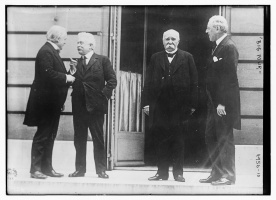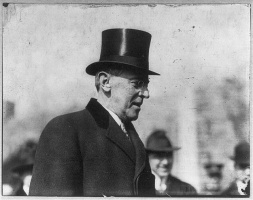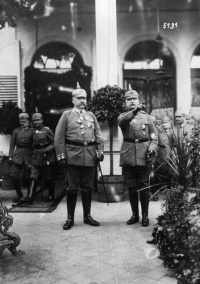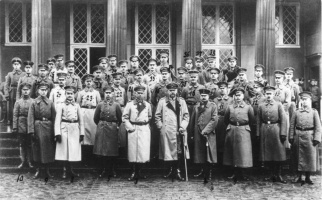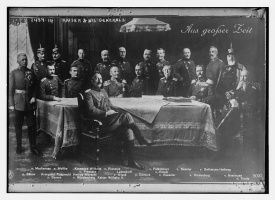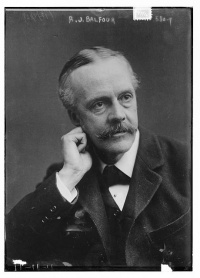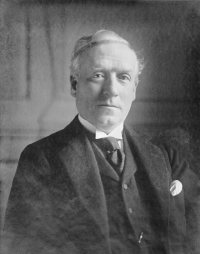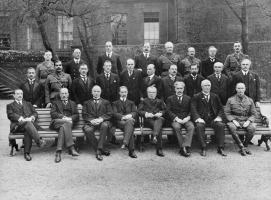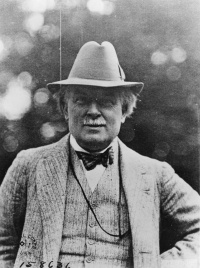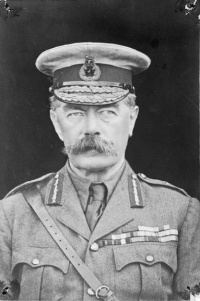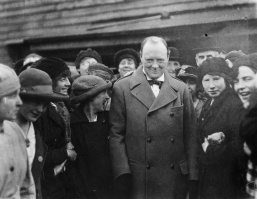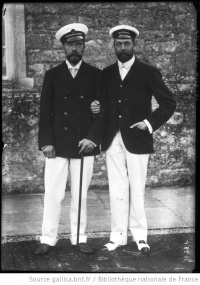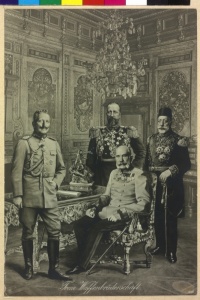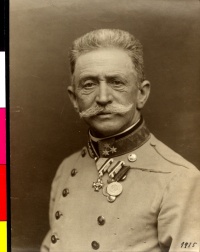Introduction↑
Militarism traditionally figures prominently in the list of general explanations of the causes of World War I. A strong martial spirit prevailed in all of the major European countries, and the five continental powers each maintained a large military establishment, while Britain and the United States, an emerging great power, had small volunteer armies but maintained large fleets. In the years before 1914 the leading states each in its own way considered military or naval prowess a supreme ideal, and each subordinated other interests to those of the armed forces. Yet even in the states where monarchs, strongly influenced by military leaders, held the ultimate authority, they did not act without the counsel and consent of civilian ministers or civilian representative bodies. The wars of 1899-1913 in South Africa, the Far East, and the Balkans provided ample evidence that a successful modern war effort required the wholehearted support of the home front, and that in an age of nationalism, civilians were willing, even eager, to provide such support. But for most of the great powers, for most of 1914-1918, leaders found that when civilian populations embraced a modern war effort, they had difficulty accepting anything less than total victory.
Civilians, Soldiers, and Separation of Powers↑
For each of the great powers that were fully engaged in the war by its end, the head of state or chief executive held the role of commander-in-chief of the armed forces. For the French and American republics, as well as for the parliamentary monarchies of Britain and Italy, this constitutional feature ensured ultimate civilian control over the military. The least ambiguous situation was in the United States, where (thanks to the precedent set by Abraham Lincoln (1809-1865) during the American Civil War) the chief executive claimed sweeping war powers that Congress would not attempt to limit until the War Powers Act of 1973, passed in the wake of the Vietnam War. France’s president, indirectly-elected under the Third Republic, served as titular commander-in-chief with the actual war powers (like virtually all other powers) resting with the prime minister and cabinet. In an age in which all male crowned heads customarily bore military rank and more often than not appeared publicly in uniform, the military role of the British monarch was purely symbolic, while the kings of Italy held considerable power in theory but traditionally deferred to the politicians. Unlike true constitutional monarchies, Germany and Austria-Hungary gave their monarchs sweeping powers to conduct foreign policy and war; both had emperors who considered themselves soldiers, yet during the crisis of 1914 and the war that followed, Wilhelm II, German Emperor (1859-1941) and Francis Joseph I, Emperor of Austria (1830-1916) deferred to actual soldiers in military decision-making. Nicholas II, Emperor of Russia (1868-1918) did not consider himself a soldier but likewise wielded considerable power in military matters; in 1914 he deferred to his generals, then the following year assumed personal command of his country’s war effort, with fateful consequences.
In the ministerial sense, Britain and the United States had the strongest traditions of civilian control over the military. Under Britain’s constitutional monarchy, civilian ministers held the cabinet-level posts of first lord of the admiralty and secretary of state for war, and likewise, in the United States, the war secretary and navy secretary were civilians. In contrast, in the Italian constitutional monarchy as well as in France’s Third Republic, the war minister and navy minister were almost always active-duty senior officers. The same had been true in Imperial Russia under royal absolutism, and continued to be the case under the constitutional monarchy established after the Revolution of 1905.
Under the federal structure of Germany’s Second Reich, the individual kingdom-level states (Prussia, Bavaria, Saxony, and Württemberg) theoretically controlled their own ground forces, leaving the general serving as war minister of Prussia (which encompassed two-thirds of Germany’s territory, and also controlled the forces of the smaller German states) to function as de facto war minister for the entire country. Meanwhile, the German navy was a true national institution, under the administrative direction of the state secretary for the Imperial Navy Office, likewise a senior officer on active duty.
The complex constitutional structure of the Dual Monarchy of Austria-Hungary, established in the so-called Compromise of 1867, governed the former Austrian Empire after its transformation into two states with separate laws, governments, economies, and even citizenship, sharing in common only a monarch, foreign policy, and armed forces. The unique structure included three war ministers, because reserves and home security were delegated to the two states, leaving the Austro-Hungarian war minister responsible only for the front line units of the common army. All three war ministers were senior officers on active duty, as was the head of the naval section of the common war ministry, responsible for the Austro-Hungarian fleet. In all countries where officers exercised ministerial responsibility over military and naval affairs, their posts were considered less prestigious than the general staff chiefs who, in wartime, served as de facto if not de jure commanders of their respective armed forces. The staff chiefs typically also outranked the general officers holding ministerial posts, further undercutting them and ensuring their deference especially after the fighting started.
In all of these countries, the right of elected representative bodies to approve or reject military budgets ensured a civilian voice in military affairs, though after the war started, public opinion and patriotism left few politicians willing or able to use their potential vote against military expenditure as a means of influencing policy. In the less democratic states, constitutional provisions restricted the prerogatives of the elected representatives in the area of military spending. Under the constitution (“Fundamental Laws”) of 1906, the Russian Duma could not use its budgetary authority to reduce the size of the army (which, in case of a political impasse, was guaranteed to be no less than the previous year’s level of manpower). The German Reichstag approved the army’s funding five years at a time, and was bound by Admiral Alfred von Tirpitz’s (1849-1930) navy laws to replace each old warship with a new one after a fixed number of years, with the replacement reflecting the state of the art at the time. During the Anglo-German naval race of the immediate pre-war period, this provision enabled the German navy to “replace” obsolete ironclads as small as 3,000 tons with modern battleships exceeding 20,000 tons, without further Reichstag approval. In Austria-Hungary the elected legislators found their influence limited by the unique constitutional structure of the Dual Monarchy, under which all common Austro-Hungarian expenditure (including appropriations for the frontline units of the army as well as all naval spending) was approved annually by indirectly elected delegations representing the Austrian and Hungarian parliaments. The two houses of lords controlled one-third of the seats in the delegations, and their numbers, added to those of pro-government representatives from the two lower houses, sufficed to guarantee passage of military bills.
Decisions for War↑
In Austria-Hungary, the right to declare war rested with the emperor, acting upon the advice of the Common Ministerial Council, which consisted of the joint Austro-Hungarian ministers for foreign affairs, war, and treasury, plus the prime ministers of Austria and Hungary. Under the Compromise of 1867 the emperor theoretically presided over the council but, in his absence, the foreign minister chaired it. As Francis Joseph grew older, he seldom joined the ministers in person, and not at all in the days following the assassination of Franz Ferdinand, Archduke of Austria-Este (1863-1914). During the July Crisis of 1914 his only conditions were that any decision for war would have German support and Hungarian approval; the Hoyos Mission to Berlin (5-6 July 1914) secured the former, while Prime Minister István Tisza (1861-1918) ultimately, and reluctantly, provided the latter. Franz Conrad von Hötzendorf (1852-1925), chief of the general staff, had long advocated war as a solution to the Serbian problem but at this juncture did not have to persuade the civilian ministers to act, as all but Tisza had already come round to his point of view, that any outcome other than war would compromise Austria-Hungary’s status as a Great Power. He only attended two meetings of the council during July 1914, at which he distinguished himself from his counterparts in other countries by outlining his war plans to the civilian leaders in great detail. Foreign Minister Count Leopold Berchtold (1863-1942) took the lead in crafting the ultimatum to Serbia, with input from the other ministers. In the last days of July 1914, the Common Ministerial Council affirmed the decision to proceed with war against Serbia even after it became clear that it would also mean war against Russia and a general conflict for Europe. Along the way, Francis Joseph dutifully signed the requisite declarations of war and mobilization orders.[1]
In Russia, as in Austria-Hungary, the decisions leading to war were taken by the emperor’s ministers, then promulgated by the monarch who alone held the constitutional power to declare war. The Imperial Russian cabinet, all civilians except the war and navy ministers, conducted its fateful deliberations on 24 July 1914, the day after the ultimatum to Serbia. Like their Austro-Hungarian counterparts, the Russian ministers considered a firm stand essential to maintain their country’s status as a great power. Foreign Minister Sergei Sazonov (1861-1927) was the most outspoken voice for mobilization, and only the finance minister, Pyotr Bark (1869-1937), hesitated before making it unanimous. The war minister, General Vladimir Sukhomlinov (1848-1926), and the navy minister, Admiral Ivan Grigorovich (1853-1930), assured their colleagues that Russia was strong enough to fight. They saw nothing but opportunity in the present crisis. Confident that the Russian army would crush Austria-Hungary, and assuming Germany’s initial moves would be against France, the ministers succumbed to a hubris in which the only choice seemed to be which of the Central Powers to attack first (Russia ultimately attacked both simultaneously). Nicholas II joined their discussions on 25 July 1914, confirmed their decision, then on 26 July 1914 announced Russia’s “period preparatory to war,” a key event in setting off the sequence of ultimata and mobilizations that led most of Europe to war within the following ten days. The tsar ordered a general mobilization of the Russian army on 29 July 1914, only to have second thoughts and countermand the order that evening. Besieged by protests from his civilian ministers as well as his generals, he soon relented, and the Russian mobilization was on again, effective 31 July 1914.[2]
Since late 1912, during the First Balkan War, the leaders of Germany had stood ready to exploit any crisis to get a general war, provided that Russia appeared to be the aggressor and Britain remained neutral. Wilhelm II and his ministers felt confident that if the tsar were the first to proclaim a general mobilization, even the Social Democrats (the largest party in the Reichstag and the only one that had always voted against military appropriations) would support the funding for Germany to respond. While the strategic decision to exploit the crisis was based on chief of the German General Staff Helmuth von Moltke the Younger’s (1848-1916) calculation that by 1917 the combination of France and Russia would be too powerful for Germany to overcome, civilians played the key role in getting Germany the war its General Staff wanted. Chancellor Theobald von Bethmann Hollweg (1856-1921) bore the responsibility for orchestrating the Reichstag’s support, while Foreign Secretary Gottlieb von Jagow (1863-1935) managed the diplomatic side. The Russian general mobilization of 31 July 1914 brought an end to peace demonstrations sponsored by the Social Democratic party and its affiliated trade unions, unifying German public opinion perhaps as never before. On 4 August 1914, even as Britain stood poised to enter the war, thus spoiling the calculations of the German leadership, the Reichstag voted on a budget of 5 billion marks in war credits to cover the mobilization and initial expenses of the war. Though some still harbored deep misgivings, the Social Democrats voted unanimously in favor of the bill, confirming that Russia, by being the first to initiate a general mobilization, had cast itself in the role of aggressor in the eyes of the German public, including the socialists, and endowed the German cause with a sense of righteousness that blinded most Germans to the role their own leaders had played in escalating the conflict.[3] In the first days of August 1914, very few Germans found fault with the Schlieffen Plan’s logic that in order to defend itself against Russia, Germany had to attack France first and violate Belgium in the process.
In France, civilian leaders made all of the decisions in July 1914. The crisis unfolded while President Raymond Poincaré (1860-1934) and Premier René Viviani (1863-1925) were abroad, having left on 16 July 1914 for a state visit to Russia and the Scandinavian countries, including three days in St. Petersburg, but historians have long exaggerated the role of their long-planned trip in the timing of the key machinations of the Central Powers. Returning to Paris on 29 July 1914, the president impressed upon the cabinet that in the present crisis France must have a united home front and the support of Britain, both of which could be achieved only by allowing Germany to be the aggressor. To ensure that the French army did nothing that could be considered provocative, Poincaré ordered units deployed along the border to pull back six miles (ten kilometers) into France, a move they carried out on 30 July 1914. Five tense days passed before Britain declared war on Germany, with the violation of Belgium playing a greater role than any deeply held desire to stand by France, yet with the British committed the French got the war they wanted, or at least war under the circumstances Poincaré had outlined upon his return from Russia. Casting Germany in the role of aggressor was as important to French domestic unity as Russia’s mobilization was to German domestic unity. The fundamental division between conservative Catholics and liberal secularists that plagued the country during and after the Dreyfus Affair (1894-1906) persisted, but for most of the war the French people and the political parties representing them rallied in what Poincaré called the “sacred union” (union sacrée), in defense of the endangered nation. In an important early sign of this unity, Socialist party leader Jean Jaurès (1859-1914) supported Poincaré from the moment he returned from Russia, and his party remained behind the government after a right-wing fanatic assassinated Jaurès on 31 July 1914. Germany’s declaration of war (3 August 1914) and subsequent invasion brought an end to whatever dissent remained on the French home front.[4]
In Britain, as in France, the decision for war rested entirely with the civilian leadership. Herbert Henry Asquith’s (1852-1928) Liberal government included two ministers particularly keen to support the French and resist German aggression. Foreign Secretary Sir Edward Grey (1862-1933) had engendered closer relations with France and, in 1907, negotiated the Anglo-Russian rapprochement that provided the third leg of the triangle in the Triple Entente. Winston Churchill (1874-1965), as First Lord of the Admiralty, had led Britain’s robust response to Germany’s Tirpitz Plan during the Anglo-German naval race. Without consulting their colleagues, in the last days of July 1914 Grey warned the Germans that Britain would not remain neutral in a continental war between its Entente partners and Germany, while Churchill ordered the British fleet not to disperse from a practice mobilization to order to remain ready for war. For Grey, the German invasion of Belgium was a godsend, as nothing up to that point had worked to sway the non-interventionists within his own party.
In the House of Commons, the opposition leaders presented no serious obstacles; on 3 August 1914, when the foreign secretary made his final appeal for war, Conservative leader Andrew Bonar Law (1858-1923) and Irish Parliamentary party leader John Redmond (1856-1918) endorsed his remarks, leaving only James Ramsay MacDonald (1866-1937) of Labour (at the time a small fourth-party, holding just 6 percent of the seats) to advocate neutrality. The key conversion came in Grey’s own Liberal party. Germany’s bullying of Belgium so outraged the leading non-interventionist, future Prime Minister David Lloyd George (1863-1945), that it converted him overnight into a passionate supporter of British intervention. Lloyd George supported a sharply worded British ultimatum to Berlin drafted by Asquith and Grey, demanding an end to all hostile action against Belgium. Early on 4 August 1914 the ministers secured George V, King of Great Britain’s (1865-1936) constitutional consent for a declaration of war in the event the ultimatum went unanswered. Thus Britain declared war on Germany at the end of that day, with the full support of Parliament aside from a small Labour faction, but without a vote in the House of Commons.[5]
The major powers entering the war after 1914 – Italy and the United States – did so under very different circumstances, with the ultimate decisions reflecting Italian and American constitutional idiosyncrasies. Under the leadership of Prime Minister Antonio Salandra (1853-1931), Italy broke ranks with its Triple Alliance partners in the summer of 1914, declared neutrality, then joined the Entente in the spring of 1915 in exchange for promises of sweeping territorial gains at the expense of Austria-Hungary. The opportunism in this course left the Italian public and political opinion deeply divided, reflecting a nation not emotionally invested in the decision to go to war, and in May 1915, after committing Italy to the Entente in the secret Treaty of London (26 April 1915), Salandra failed to secure a parliamentary majority in support of his policy. By precedent (the British constitutional model, followed since the creation of the kingdom of Italy in 1861), a prime minister whose policy had been repudiated should have been forced to resign, but at that point Victor Emmanuel III, King of Italy (1869-1947) intervened, exercising his de jure powers both to retain a prime minister who did not command a majority and to declare war on his own constitutional authority. In the United States, German unrestricted submarine warfare gradually turned public and political opinion against the Central Powers over the two years preceding April 1917, when President Woodrow Wilson (1856-1924) asked Congress for a declaration of war. What followed contrasted sharply with the aftermath of the Japanese attack on Pearl Harbor in December 1941, when President Franklin Roosevelt (1882-1945) delivered a seven-minute speech followed by forty minutes of deliberations and came away with a near-unanimous declaration of war against Japan (no dissenting votes in the Senate, one in the House). Wilson’s request touched off four days of debate before the legislators authorized hostilities on 6 April 1917, by margins that were overwhelming but far from unanimous (six dissenting votes in the Senate, fifty in the House).[6]
Civilian Support for the War and War Aims↑
With the important exception of Germany, widespread pro-war enthusiasm was nowhere to be found until after the declarations of war, when it was also stronger in Germany than elsewhere. Even after 1918, many Germans harked back fondly to the “August Days” of 1914 as a watershed in their political culture, when the public had taken ownership of the nation. Afterward, Wilhelm II remained the figurehead of nationalist sentiment, invoking the unifying image of a medieval city under siege in calling for a Burgfrieden – literally, peace within the walls of the castle – as long as the external threat persisted. But the people’s sense of nationhood could no longer be directed from above in the traditional way. For Germany, August 1914, and the embellished memories of it, helped to lay the foundation for National Socialism in that it set a powerful example of how a national community could be united in a great cause and in a spirit that transcended the traditional divisive boundaries of social class.[7]
The absence of genuine enthusiasm for war elsewhere should not be interpreted as evidence of widespread anti-war sentiment. No less than for Germany against Russia in particular (and against “encirclement” by the Entente in general), in the cases of Austria-Hungary against Serbia, France against Germany, and Britain (on behalf of Belgium) against Germany, the public generally accepted the argument that the war was defensive and the decision to fight it justifiable. Nowhere did the military leaders play a role in fanning the flames, because they did not have to. Indeed, in a broader, often vaguer sense, people across Europe supported their leaders in accepting war as necessary or even beneficial for their country. Just as there were socialists who welcomed the war as a vehicle for social leveling or even more radical revolutionary change, there were conservatives who saw the conflict as an opportunity for a religious revival or a return to pre-industrial traditional values. Across the political spectrum, patriots in many countries viewed the war as a potential catalyst for “national renewal.” Such sentiments created an atmosphere in which the belligerents not only persisted in fighting but raised the stakes for peace, even as the conflict stalemated, then became far bloodier and costlier than anyone had envisaged.
The Germans went farther than most in laying out a program of war aims, and also did so earlier, in the so-called “September Program” of 1914. Chancellor Bethmann Hollweg formulated the grand design, ironically dated 9 September 1914, the day of Germany's defeat at the First Battle of the Marne. The program called for the creation of a Mitteleuropa under German domination, the annexation of Luxembourg, the relegation of Belgium and the Netherlands to German satellites, the liberation of Poland and Russia’s non-Russian peoples (whose new states would form a buffer for Germany in eastern Europe), the annexation of some French territory, and the reduction of France to an economic dependent of Germany. The “September Program” also revealed Berlin’s revolutionary goals beyond Europe, as it included a radical redrawing of colonial borders in Africa, where the Belgian Congo would become centerpiece of a German Mittelafrika. The program, reflecting economic rather than military goals, was largely Bethmann Hollweg’s own work, drafted with the understanding that the generals would be consulted only after victory had been achieved, to fill in details such as which French borderlands were to be annexed.[8]
While none of the other powers articulated such a sweeping program, all had war aims of their own, and none would accept a compromise settlement based upon the status quo ante. Britain had refused before the war to recognize the permanence of Germany’s possession of Alsace-Lorraine (proposed by Bethmann Hollweg as part of a deal to end the Anglo-German naval race), and once the war started the British supported France’s war aim of securing the return of those lost provinces. After the Ottoman Empire joined the Central Powers in the autumn of 1914, Russia pursued its age-old dream of securing Constantinople while the British and French, joined in 1915 by the Italians, devised various plans to partition Asia Minor and the Arab lands. The terms of Italy’s accession to the Entente (in the secret Treaty of London) promised the Italians sweeping gains at Austria-Hungary’s expense, along the Adriatic as well as in the Alps, even though the former included Dalmatian territory also coveted by Serbia. The dream of a South Slav (Yugoslav) state under Serbian leadership likewise required, at the least, the truncation or dismemberment of Austria-Hungary. The outright destruction of the Dual Monarchy was not initially a war aim of Britain, France, or Russia, but after prominent Czech politicians went into exile early in the war, leaders of Austria-Hungary’s other Slavic nationalities followed them to the capitals of the Entente, where their agenda (initially for autonomy, then outright independence) gradually worked its way onto the list of Allied war aims. Beyond Europe and the Middle East, by the spring of 1915 the Allies had taken possession of most of Germany’s African and Pacific colonies, which they planned to divide among themselves at the peace table.
Thus, while the war aims of the Allied powers were never articulated in a single program like those of Germany, their ambitions grew as the war progressed and were no less a factor in precluding a negotiated peace. At least during the first three years of the war, public opinion in all countries generally favored a victorious peace, one that necessarily would include such gains. These feelings only intensified as more men died, for without victory their sacrifice would be in vain.
Civilian Leaders and the Conduct of the War↑
The Central Powers↑
Shortly after the onset of war, various versions of martial law or a state of siege went into effect throughout Europe, as legislators dutifully passed or acquiesced to extensive restrictions on civil liberties. After 4 August 1914, the day the German Reichstag unanimously approved the initial round of war credits, it retained only the power to approve further funding for the war. The Reichstag reconvened for this purpose in December 1914, then again the following March, after which it was never out of session for more than three months at a time for the remainder of the war. Initially the parties of the Reichstag posed no problem for Bethmann Hollweg, but as the war continued, Germany’s relative success on the battlefield made it more difficult for him to preserve the united front of the Burgfrieden. The conservative parties remained enthusiastic supporters of the chancellor’s “September Program” for a victorious peace with territorial annexations – indeed, more enthusiastic than Bethmann Hollweg himself – while the Social Democrats grew less comfortable supporting a war that no longer looked much like a defensive struggle against a threat from tsarist Russia. In December 1914, Karl Liebknecht (1871-1919) became the first Social Democrat to break ranks and vote against further funding for the war. By December 1915, forty-two Social Democrats (accounting for 11 percent of the Reichstag, and 38 percent of their party’s delegation) either opposed further war credits or abstained from voting.[9]
The overt militarization of the German home front did not begin until the following year, after the bloodbaths at Verdun and the Somme resulted in the appointment of Paul von Hindenburg (1847-1934) and Erich Ludendorff (1865-1937) to head the German High Command.[10] The generals proposed new quotas in war production that could not be achieved without greater military control over civilian labor, which the Reichstag approved in December 1916 in the Patriotic Auxiliary Service Law, but only after Bethmann Hollweg narrowed the scope of the High Command’s requests, for example limiting compulsory service to males and leaving the universities open. The Reichstag also included in the legislation workers’ right to maintain unions in war industries and provisions for the arbitration of labor disputes. The bill passed on the strength of a heretofore unusual coalition of Left Liberals, Catholics, and Social Democrats, with the conservative parties abstaining to reflect their displeasure over the concessions to the workers.[11]
The chancellor faced new challenges after the abdication of Nicholas II in Russia’s March Revolution, followed a month later by the entry of the United States into the war; this transformed the Allies into a more coherent group of constitutional states and made the chancellor’s new center-left majority increasingly self-conscious about supporting an autocratic regime. Bethmann Hollweg persuaded Wilhelm II to issue a promise of post-war constitutional reform, delivered the day after the United States declared war, but his remarks only unleashed forces they would be unable to control. In July 1917, when the center-left parties proposed a peace resolution, less than a third of the Reichstag voted against it. Wilhelm II, Hindenburg and Ludendorff officially ignored the resolution but afterward, at the insistence of the generals, the emperor sacked Bethmann Hollweg in favor of the bureaucrat Georg Michaelis (1857-1936), who soon gave way to Georg von Hertling (1843-1919), the conservative prime minister of Bavaria.
As the war entered its last year, the definitive end of the Burgfrieden left the country deeply divided. The political right, reorganized after September 1917 under the banner of the new Fatherland Party, kept faith with Hindenburg and Ludendorff in their quest for decisive victory, while the peace resolution of July 1917 put the center-left parties on record supporting a compromise to end the war.[12] While events in Russia energized Germany’s revolutionary left, home front shortages and overall war-weariness fuelled massive strikes by the winter of 1917-18. In the autumn of 1918, after the generals had lost the war, they called upon the peace parties to form a government and get the best possible deal for Germany. This cynical maneuver would enable the military leaders to evade responsibility for the defeat, ensuring instead that the center-left parties (whose leaders soon founded the postwar republic) were tainted by the unfavorable outcome.[13]
In Austria-Hungary, the onset of the war brought no change in parliamentary political life in the Austrian half of the empire, where the prime minister, Karl, Graf von Stürgkh (1859-1916), had suspended the chaotic twenty-two-party Reichsrat in March 1914 in response to the obstructionist behavior of the Czech parties and the Social Democrats, resorting to government by decree using Francis Joseph’s emergency powers. With the onset of war and martial law, Stürgkh deferred to Conrad von Hötzendorf and other military officials who, at least until 1916, exercised greater authority over civilian life in Austria than their counterparts in Germany. Meanwhile, the Hungarian prime minister, Tisza, kept the parliament in Budapest in session as a means of providing greater legitimacy for his own wartime actions; politically, he could afford to do so, as the narrow Hungarian franchise (offering voting rights to just 10 percent of the population) gave him a far more predictable and cooperative legislature than the universal male suffrage of the Austrian half of the empire gave Stürgkh’s Reichsrat.
In October 1916, shortly after the Central Powers adopted a unified command structure, placing Austria-Hungary even more under the control of Germany, the Austrian home front was rocked by the sensational assassination of Stürgkh by antiwar activist Friedrich Adler (1879-1960), son of Viktor Adler (1852-1918), founder and head of the Austrian Social Democratic party. A month later, the death of Francis Joseph brought his great-nephew, Charles I, Emperor of Austria (1887-1922), to the Habsburg throne. As in Germany, in Austria-Hungary the demise of Imperial Russia and the entry of the United States into the war prompted promises of political change. In May 1917, Emperor Charles reconvened the Austrian Reichsrat, which had not met since March 1914, and accepted the resignation of the Hungarian prime minister, Tisza, after he refused to broaden the Hungarian franchise. But in Austria-Hungary, as in Germany, gestures toward reform unleashed forces the government could not control. By the time the Dual Monarchy entered the war’s last year, virtually all of its nationalities and political parties had begun to focus on the postwar future and their likely places in it.[14]
The Allied Powers↑
In the first weeks of the war, the governments of the leading Allies enacted restrictions on civil liberties no less extensive than those of the Central Powers. Even in Britain, traditionally the most liberal of Europe’s great powers, the Defence of the Realm Act (8 August 1914) made citizens liable to arrest without warrant, imprisonment without charges being filed, and trial before courts-martial for violation of an ever-growing list of restrictions on what they could say and do, all in the name of national security and wartime exigency. The day after Britain declared war, Asquith broke with precedent by appointing Britain’s leading soldier, Field Marshal Lord Horatio Herbert Kitchener (1850-1916), to the post of war minister. Asquith and Kitchener both believed military service should remain voluntary, and the government used the image of the popular field marshal to encourage enlistment. Unlike the uniformed war ministers of the continental powers, Kitchener outranked the army’s leading field commanders, Sir John French (1852-1925) and Sir Douglas Haig (1861-1928), leaving his prerogatives unquestioned.
Aside from the addition of Kitchener, Asquith continued with an all-Liberal cabinet and did not form a coalition government until May 1915, after the disastrous start of the Gallipoli Campaign. In addition to Churchill’s resignation from the Admiralty, other significant changes included Lloyd George assuming the new post of minister of munitions. During 1915 Gallipoli joined the broader stalemate of the Western Front in depressing enlistments, forcing Asquith and Kitchener to agree to a conscription law, passed by Parliament in January 1916. After Kitchener was lost at sea on a mission to Russia in June 1916, the War Office returned to civilian leadership under Lloyd George, who went on to succeed Asquith as prime minister in December 1916.
During the last two years of the war, Lloyd George led the most stable and unified of the Allied governments, with a cabinet including former Conservative Prime Minister Arthur Balfour (1848-1930) as foreign secretary, and Churchill, back from a brief sojourn as an army officer in the trenches in France, holding Lloyd George’s former portfolio as munitions minister. Britain’s response to the militarization of German factory labor under Hindenburg and Ludendorff, Neville Chamberlain’s (1869-1940) National Industrial Service, was, in contrast to the German program, both civilian-run and voluntary, and also a colossal flop, attracting just 20,000 of a projected 500,000 workers to Britain’s war industries. Britain ultimately employed more women in war industries than any other country in World War I, and their involvement in the wartime economy was responsible, at least indirectly, for women getting the vote as of March 1918, when Parliament passed the Representation of the People Act by a wide margin.[15]
For Russia, the onset of hostilities in 1914 brought the suspension of the Duma, which delegated its powers to Prime Minister Ivan Goremykin (1839-1917) and his cabinet for the duration of the war. In the summer of 1915, with discontent growing on the home front and the Russian army in full retreat out of Poland, Nicholas II agreed to reconvene the Duma but at the same time rejected appeals to replace the Goremykin government with a “ministry of national confidence.” His refusal to appoint a more effective cabinet alienated even the conservative parties that had supported him in the pre-war Duma; they went into opposition, insisting upon constitutional reforms.
In September 1915 Nicholas II went to the front to take personal command of the army, a decision which made the chief of staff, General Mikhail Alekseev (1857-1918), de facto commander and, fatefully, left Alexandra, Empress, consort of Nicholas II, Emperor of Russia (1872-1918) and her confidante, the eccentric Grigori Rasputin (1869-1916), to fill a leadership vacuum in Petrograd. During 1916 Nicholas II entrusted a favorite of Rasputin, Baron Boris Shtiurmer (1848-1917), with the roles of prime minister, interior minister, and foreign minister, but the German-surnamed Stürmer only joined the German-born Alexandra as a lightning rod for conspiracy theories.
Yet even as strikes and demonstrations became widespread during the winter of 1916-17, the circle of politicians, generals, and noblemen best positioned to take action could not reach a consensus on what to do to save Russia, other than get rid of Rasputin (murdered in December 1916). Nicholas II finally forced their hand in March 1917 by dissolving the Duma and authorizing the Petrograd garrison to fire on protesters. Within the span of five days (10-15 March 1917) troops deployed against demonstrators joined them instead, sparking a general mutiny; the Duma refused to disperse, instead forming the Provisional Government; and finally, the army’s leading generals, including Alekseev, persuaded the tsar to abdicate.
While, in theory, the Provisional Government inherited the authority of the tsarist regime, in fact it had to accept “dual power” with a network of soviets (revolutionary councils) formed by workers, peasants, soldiers, and sailors, under the leadership of the Petrograd Soviet. Alexander Kerensky (1881-1970) of the Socialist Revolutionary party was the only member of both the Provisional Government and the Petrograd Soviet, and provided a crucial link between them. He served as the Provisional Government’s war minister and, eventually, also prime minister, sanctioning a disastrous summer offensive against the Central Powers. Thereafter, Vladimir Lenin’s (1870-1924) Bolsheviks, the only unmistakably antiwar party, gained popularity within the soviets and in the ranks of the armed forces. Kerensky attempted to suppress them but, in September 1917, had to rely upon their support to fend off a coup by General Lavr Kornilov (1870-1916), whom he had entrusted with command of the army following the failed offensive. Afterward Kerensky could exercise authority only with the approval of the soviets. On 7-8 November 1917, after securing majorities in the Petrograd and Moscow soviets, the Bolsheviks easily toppled Kerensky, then formed their own government and pulled Russia out of the war. Thus the military leadership stood by the tsar until he discredited himself, at which point Alekseev played a key role in removing him; then, in 1917, the generals supported the Provisional Government until it, too, proved too weak to govern, prompting Kornilov to attempt his coup. Unable to stop the Bolsheviks from coming to power, many of the generals actively opposed them until their “White” armies were defeated in the Russian Civil War (1918-21).[16]
Russia, despite its weaknesses, played an important role in the psychology of the French home front, which took solace that the existence of an extensive Eastern Front presented a reasonable hope for victory (a hope France would not have the next time it faced a German invasion, in 1940). Among the major belligerents, France in 1914-1915 suffered more casualties, per capita, than anyone else, and in the first weeks of the war lost 6 percent of its territory to foreign occupation, more than any of the others would in the entire war. Yet Poincaré’s union sacrée held and morale did not collapse, even when the initial German advance on Paris prompted the government to relocate to Bordeaux for three and a half months. The interlude in Bordeaux had fateful consequences, however, in that it gave General Joseph Joffre (1852-1931), commander-in-chief of the army since 1911, the opportunity to assert his prerogatives at the expense of civilian authority, creating a tense civilian-military relationship that persisted as long as he remained in command.
Under the union sacrée, the cabinet of René Viviani (and that of his successor, Aristide Briand (1862-1932), after October 1915) encompassed a broader spectrum of political opinion than the wartime government of any other country, from socialists to Catholic conservatives. In the first forty years of the Third Republic, twenty-five of the thirty men to serve as war minister were generals, but from 1914-1916 a civilian politician from the left, Alexandre Millerand (1859-1943), held the post. Millerand’s tenure was problematic for civilian-military relations not because he clashed with Joffre, but rather because he deferred to him too much. The French socialists, like the German Social Democrats, voted unanimously for war credits in August 1914 but began to see more of their members drift into opposition to the war during 1915. To head off labor disputes that could hurt war production, Viviani appointed a socialist, Albert Thomas (1878-1932), to the post of undersecretary for munitions in the War Ministry. Thomas was so effective that Briand, in December 1916, rewarded him with full ministerial status. Meanwhile, during the protracted bloodbath at Verdun (February-December 1916), the French Chamber and Senate both convened secret sessions increasingly critical of Joffre, ultimately demanding a change in command.[17] At the end of the year Briand sacked Joffre in favor of General Georges Nivelle (1856-1924), who in turn gave way to Henri Pétain (1856-1951) after the failure of his spring 1917 offensive.
The failure of the Nivelle offensive (coinciding with the abdication of the tsar) brought the first significant public rejection of the union sacrée by members of the French Left. Advocates of a compromise peace included Radical party leaders Joseph Caillaux (1863-1944) and Louis-Jean Malvy (1875-1949). Thomas, the last prominent socialist in the cabinet, resigned in September 1917, causing the short-lived government of Alexandre Ribot (1842-1923) to fall. At that point President Poincaré weighed the options of forming a government under Caillaux, which would seek peace with the Germans, or the old Radical leader Georges Clemenceau (1841-1929), which would fight to the finish. In November, Poincaré opted for Clemenceau, who formed a center-right cabinet. He promptly sent a strong message to the defeatists by ordering the arrest of Caillaux and Malvy on treason charges. Clemenceau, serving as his own war minister, also asserted a greater degree of civilian control over the military, but in the process he also defended the army from its detractors. The fiery seventy-six year old lived up to his nickname “the tiger” by rallying the home front his own way, bullying his opponents rather than reaching out to them. His methods left the union sacrée dead in the public sphere as well as the governing coalition. In the last year and a half of the war, only the parties and politicians of the French Right even bothered to use the term.[18]
After Italy entered the war in May 1915, the passions unleashed for and against Italy’s opportunistic war of aggression only further divided a country that already ranked as the weakest of Europe’s great powers. Italy’s counterpart to Clemenceau, Vittorio Orlando (1860-1952), came to power less than a month before him, after serving first as justice minister under Salandra in 1914-1916, then as interior minister in the coalition headed by Paolo Boselli (1838-1932) in 1916-1917. Orlando became prime minister in October 1917, five days after the Central Powers broke the front at Caporetto, and thus inherited Italy’s greatest crisis of the war. A veteran Liberal politician, legal scholar, and Sicilian mafioso, Orlando possessed a unique combination of qualities that proved to be what Italy needed at that moment.
When it came to home front morale and depth of support for the war, Italy’s experience contrasted sharply with that of France. While widespread appreciation of the gravity of France’s situation led to the union sacrée at the start of the war, with the misgivings and disunity coming later, Italy entered the war deeply divided and suffered an endemic crisis in morale, fueled by doubters on both the left and the right. Italian socialists were more consistently antiwar than their comrades in other countries, while many Italian Catholics took their cue from Pope Benedict XV’s (1854-1922) opposition to the war. The debacle at Caporetto, however, provided the sort of clarity for Italy that August 1914 had produced in France.
Invoking the same sort of spirit that had recently died in France, Orlando called his cabinet of all parties the Unione Sacra, Italy’s union sacrée. In civil-military relations, he was fortunate not to have to deal with General Luigi Cadorna (1850-1928), Italy’s formidable chief of the general staff, whom Victor Emmanuel III sacked in November 1917, eleven days into Orlando’s ministry. After his elevation to chief in the summer of 1914, Cadorna had shown nothing but contempt for Salandra, Bosetti, and other civilian leaders, always demanding more men and materials, never sharing information, and taking offense when questioned about his strategy and the army’s performance. But even in the wake of Caporetto, which reduced the size of the Italian army by half, the king and his ministers hesitated to challenge Cadorna until the British and French gave them no choice, by refusing to send further aid to an army he commanded. General Armando Diaz (1861-1928) replaced him, and with the help of Allied reinforcements quickly stabilized the front.
To remedy its industrial weakness, Italy attempted a greater degree of economic militarization than any of the other Allied Powers. Under General Alfredo Dallolio (1853-1952), coordinator of munitions production, workers granted leave from the army remained subject to military discipline and, along with their non-military counterparts, often worked sixteen-hour days. The government established almost 2,000 factories during the war, most of them in the already industrialized north, but struggled to provide housing and social services for workers migrating from the impoverished south. Overall, the discipline imposed upon Italy’s wartime workers did not apply to their corrupt bosses, whose scandals forced Dallolio’s resignation in May 1918. Italy, like France, became more dependent on its allies as the war continued, but unlike the French, the Italians could not point to achievements on the battlefield sufficient to justify the postwar fulfillment of their war aims.[19]
Wartime relations between civilian and military authorities in the United States unfolded as one might expect, in the great power with the strongest tradition of civilian control over the military as well as the weakest pre-war military establishment. As soon as Congress declared war, President Wilson made clear that the army deployed to France would not be raised in the haphazard fashion typical of the American military past. He abandoned his longstanding opposition to conscription in part because Theodore Roosevelt (1858-1919) asked for permission to form and lead a unit of volunteers, along the lines of his “Rough Riders” of the Spanish-American War (1898), and the president had no intention of allowing his foremost political rival and harshest critic to command troops in France. The Selective Service Act of May 1917 provided the framework for the small peacetime army to expand dramatically to a force of 4 million men.[20]
The conscription legislation served as the centerpiece of a series of laws Congress enacted to give Wilson and the executive branch sweeping powers over the wartime economy and society, including the creation of a War Industries Board, the temporary nationalization of the railway system, an Espionage Act, and a Sedition Act. In the name of national security, the federal government expanded its power at the expense of the state governments while, within the federal government, the power of the executive branch was expanded by allowing it to define what constituted national security, establishing important precedents invoked later, during World War II and the Cold War.[21]
In choosing the commander of the American Expeditionary Force (AEF), Wilson passed over General Leonard Wood (1860-1927), a Roosevelt protégé, fellow “Rough Rider,” and former army chief of staff, in favor of General John J. Pershing (1860-1948), commander of the recent American intervention in Mexico against Pancho Villa. Wilson then gave Pershing greater leeway in determining American military strategy and policy than any other wartime president ever had, or ever would in the future, the only caveat being that the United States should have a central role at the peace table as a result of its contribution to the final Allied victory. While the Allies wanted American troops placed at their disposal as soon as they arrived in France, Pershing recognized the political consequences of allowing them to be amalgamated into French and British divisions in this manner. He received no specific instructions from Wilson on how to deal with the amalgamation question, but knew the president could only play his desired part in shaping the postwar settlement if the troops of the AEF were given responsibility for their own sector of the Western Front, where their significance to the defeat of Germany would be clearly demonstrated.
The initial success of the German spring offensive of 1918 forced Pershing to compromise, but by that time the size of his force allowed entire AEF divisions to reinforce British and French armies. The American First Army took over the front in Lorraine in August 1918, and by October 1918, with the final offensive against Germany well underway, the Second Army deployed in the same sector. By the time of the Armistice, the AEF had 2.1 million troops in France, of whom 1.4 million had deployed to the front, where their number narrowly surpassed that of the British and Imperial forces and far exceeded the French. Thus Pershing ultimately gave Wilson the victory he desired.[22]
Conclusion↑
In Wilson’s idealistic rhetoric, World War I was “the war to end all wars” and “the war to make the world safe for democracy,” and the Allied victory a triumph of representative governments over the autocracy of the Central Powers. But for each of the victors, the war must also be judged a victory for civilian over military authority. In the last half of the war strong civilian leaders emerged to rally the home front in each of the three major European Allies: Lloyd George in Britain, Clemenceau in France, and Orlando in Italy. As the Allied generals continued their struggle to master the strategic, tactical and logistical factors that produced the ultimate victory on the battlefield, these politicians joined Wilson in crafting an outcome to the war acceptable to the people they led. In the cases of France and Italy, Clemenceau and Orlando were all the more significant because they reasserted the primacy of civilian authority after their predecessors earlier in the war had shown too much deference to military leaders. The ultimate victory of the great powers led by civilians, and disastrous defeat of an Imperial Germany in which Hindenburg and Ludendorff had become de facto political as well as military leaders, spelled an end to military strongmen at least in Europe’s great powers. In the interwar period, the one-party dictatorships (Soviet Russia, Fascist Italy, Nazi Germany), no less than the western democracies, were careful to keep the military subordinate to civilian leadership.
Lawrence Sondhaus, University of Indianapolis
Section Editor: Roger Chickering
Notes
- ↑ Sondhaus, Lawrence: World War I. The Global Revolution, Cambridge 2011, pp. 45-52. See also Sondhaus, Lawrence: Franz Conrad von Hötzendorf. Architect of the Apocalypse, Boston 2000, pp. 141ff.
- ↑ Sondhaus, World War I 2011, pp. 53ff.
- ↑ Chickering, Roger: Imperial Germany and the Great War, 1914-1918, Cambridge 1998, pp. 12ff.
- ↑ Sondhaus, World War I 2011, pp. 50, 55, 58. See also Becker, Jean Jacques: The Great War and the French People, translated by Arnold Pomerans, New York 1986.
- ↑ See Packer, Ian: Lloyd George, New York 1998; and Gregory, Adrian: The Last Great War. British Society and the First World War, Cambridge 2008.
- ↑ Kennedy, David M.: Over Here. The First World War and American Society, New York 1980, pp. 12-23.
- ↑ Chickering, Imperial Germany 1998, pp. 13-17, 34. See also Verhey, Jeffrey: The Spirit of 1914. Militarism, Myth, and Mobilization in Germany, Cambridge 2000.
- ↑ Sondhaus, World War I 2011, pp. 92f.
- ↑ Chickering, Imperial Germany 1998, pp. 61ff; Sondhaus, World War I 2011, p. 182.
- ↑ On the Hindenburg-Ludendorff regime see Kitchen, Martin: The Silent Dictatorship. The Politics of the German High Command under Hindenburg and Ludendorff, 1916-1918, London 1976; and more recently Pyta, Wolfgang: Hindenburg. Herrschaft zwischen Hohenzollern und Hitler, Munich 2007.
- ↑ Chickering, Imperial Germany 1998, pp. 80f.
- ↑ Ibid., pp. 162-66.
- ↑ Ibid., pp. 187-91.
- ↑ Sondhaus, World War I 2011, pp. 182, 340f, 347f. See also Healy, Maureen: Vienna and the Fall of the Habsburg Empire. Total War and Everyday Life in World War I, Cambridge 2004.
- ↑ See Packer, Lloyd George 1998; Gregory, The Last Great War 2008.
- ↑ Sondhaus, World War I 2011, pp. 186, 244-49, 264-67. See also Gatrell, Peter: Russia's First World War. A Social and Economic History, Harlow 2005.
- ↑ Greenhalgh, Elizabeth: The French Army and the First World War, Cambridge 2014, p. 172. See also Saatmann, Inge: Parlament, Rüstung und Armee in Frankreich 1914/18, Düsseldorf 1978.
- ↑ See Becker, Jean Jacques: Clémenceau, chef de guerre, Paris 2012.
- ↑ See Morselli, Mario: Caporetto, 1917. Victory or Defeat? London et al. 2001; Pollard, John F.: The Unknown Pope. Benedict XV (1914-1922) and the Pursuit of Peace, London 1999.
- ↑ Kennedy, Over Here 1980, pp. 147-50.
- ↑ See Ford, Nancy Gentile: The Great War and America Civil-Military Relations during World War I, Westport 2008.
- ↑ See Smythe, Donald: Pershing. General of the Armies, Bloomington 1986; Trask, David F.: The AEF and Coalition Warmaking, 1917-1918, Lawrence 1993.
Selected Bibliography
- Becker, Jean-Jacques: The Great War and the French people, New York 1986: St. Martin's Press.
- Becker, Jean-Jacques: Clemenceau, chef de guerre, Paris 2012: Armand Colin.
- Brignoli, Marziano: Il generale Luigi Cadorna capo di Stato maggiore dell'esercito, 1914-1917, Udine 2012: Gaspari.
- Chickering, Roger: Imperial Germany and the Great War, 1914-1918, Cambridge; New York 1998: Cambridge University Press.
- Ford, Nancy Gentile: The Great War and America. Civil-military relations during World War I, Westport 2008: Praeger Security International.
- Förster, Stig: Refugees and exiles, in: Winter, Jay (ed.): The Cambridge history of the First World War. The state, volume 2, Cambridge; New York 2014: Cambridge University Press, pp. 91-125.
- Gatrell, Peter: Russia's First World War. A social and economic history, Harlow 2005: Pearson/Longman.
- Greenhalgh, Elizabeth: The French army and the First World War, Cambridge 2014: Cambridge University Press.
- Gregory, Adrian: The last Great War. British society and the First World War, Cambridge; New York 2008: Cambridge University Press.
- Healy, Maureen: Vienna and the fall of the Habsburg Empire. Total war and everyday life in World War I, Cambridge 2004: Cambridge University Press.
- Kennedy, David M.: Over here. The First World War and American society, New York 1980: Oxford University Press.
- Kitchen, Martin: The silent dictatorship. The politics of the German high command under Hindenburg and Ludendorff, 1916-1918, New York 1976: Holmes & Meier Publishers.
- Morselli, Mario: Caporetto, 1917. Victory or defeat?, London; Portland 2001: F. Cass.
- Packer, Ian: Lloyd George, New York 1998: St. Martin's Press.
- Pollard, John F.: The unknown pope. Benedict XV (1914-1922) and the pursuit of peace, London 1999: Geoffrey Chapman.
- Pyta, Wolfram: Hindenburg. Herrschaft zwischen Hohenzollern und Hitler, Munich 2007: Siedler.
- Saatmann, Inge: Parlament, Rüstung und Armee in Frankreich 1914/18, Düsseldorf 1978: Droste Verlag.
- Smythe, Donald: Pershing, general of the armies, Bloomington 1986: Indiana University Press.
- Sondhaus, Lawrence: World War I. The global revolution, Cambridge; New York 2011: Cambridge University Press.
- Sondhaus, Lawrence: Franz Conrad von Hötzendorf. Architect of the apocalypse, Boston 2000: Humanities Press.
- Trask, David F.: The AEF and coalition warmaking, 1917-1918, Lawrence 1993: University Press of Kansas.
- Verhey, Jeffrey: The spirit of 1914. Militarism, myth and mobilization in Germany, Cambridge; New York 2006: Cambridge University Press.





